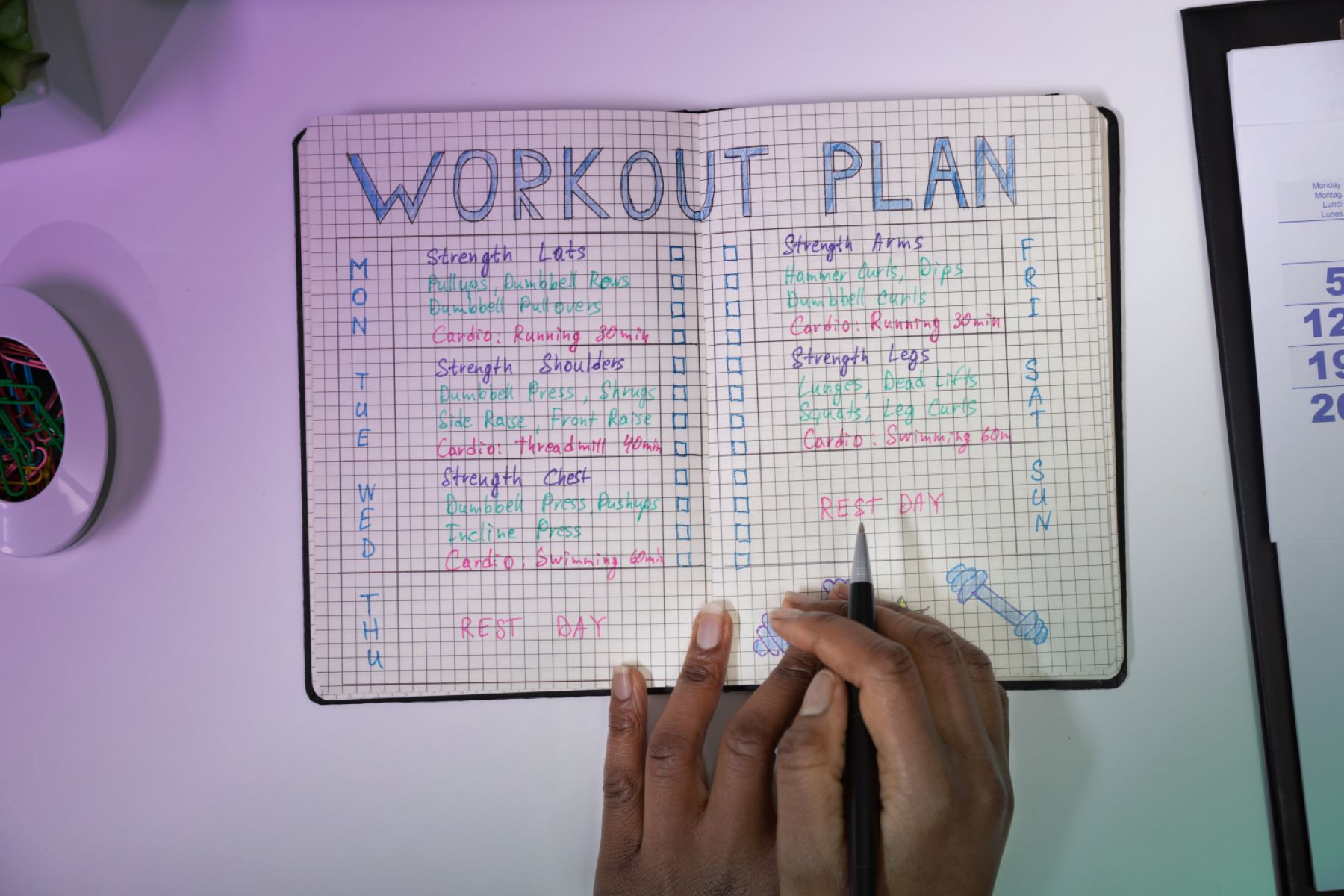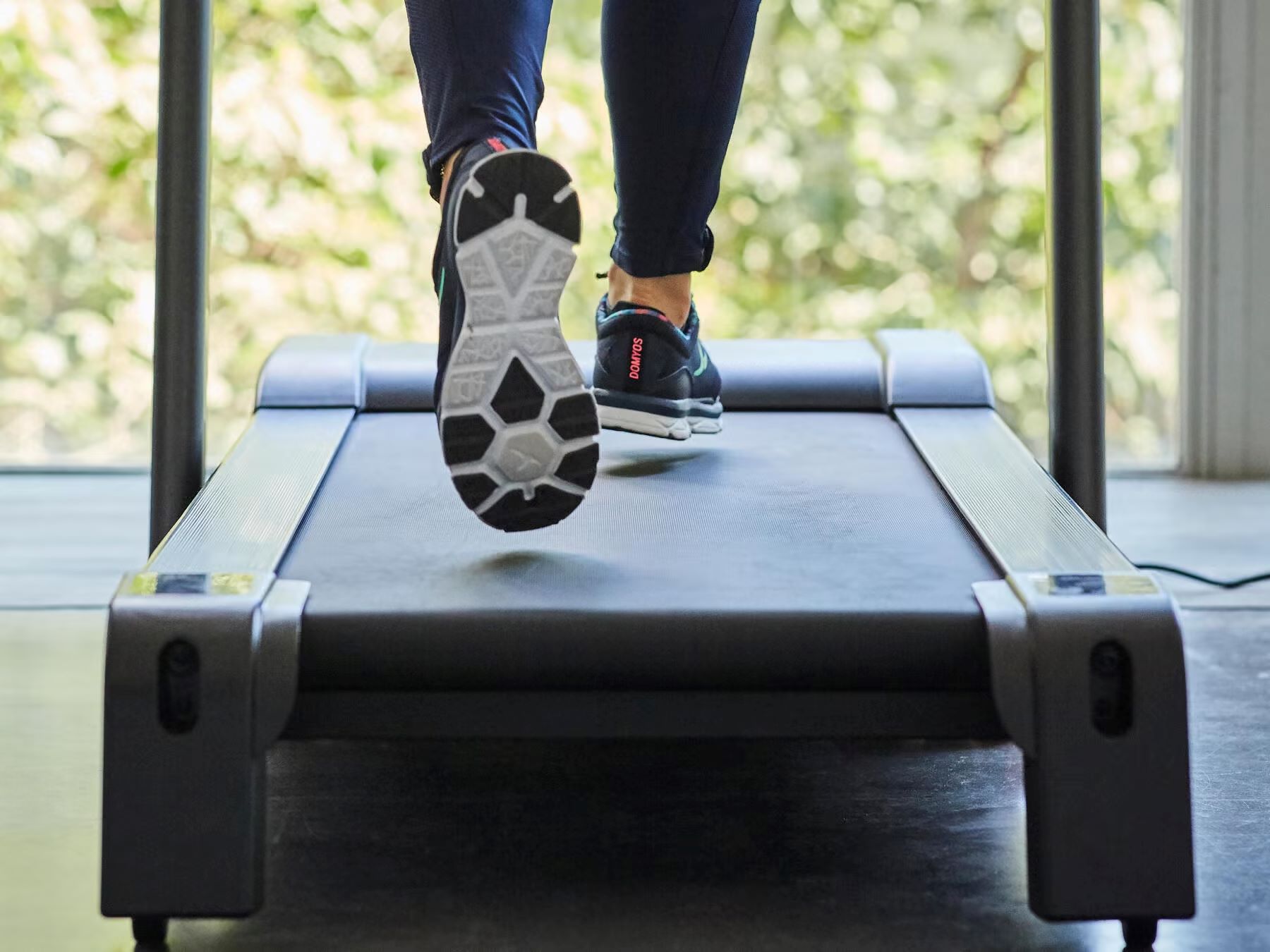

Featured
How To Start A Workout Routine
Modified: January 2, 2024
Learn how to start a workout routine with our featured tips and tricks. Find the best exercises and create a fitness plan that works for you!
Introduction
Welcome to the world of fitness and wellbeing! Starting a workout routine is a fantastic step towards improving your physical and mental health. Whether you’re a beginner taking the first stride or someone looking to recommit to a regular exercise regimen, this guide will provide you with essential tips and advice to kickstart your fitness journey.
Embarking on a workout routine can be both exciting and overwhelming. It’s crucial to approach it with the right mindset and realistic expectations. Remember, consistency is key, and patience is your best friend when it comes to achieving your fitness goals.
Regular physical activity offers a myriad of benefits, including increased energy levels, improved cardiovascular health, enhanced mood, and better sleep quality. Moreover, exercise can aid in weight management and the prevention of chronic diseases like heart disease and diabetes.
In this article, we will break down the process of starting a workout routine into manageable steps. First, we’ll discuss the importance of setting goals and finding the right type of workout to suit your preferences and needs. Then, we’ll delve into the significance of warming up, starting slowly, and staying consistent.
Additionally, we’ll explore the benefits of incorporating strength training and cardiovascular exercises into your routine. Monitoring your progress, listening to your body, and knowing when and how to increase intensity will also be covered. Finally, we’ll provide tips on creating a sustainable workout schedule and the option to seek professional assistance.
By the end of this guide, you’ll have all the tools and knowledge necessary to take the first steps on your fitness journey. So let’s lace up our shoes, put on our workout gear, and get ready to revolutionize our lives through exercise!
Setting Goals
Before embarking on your workout routine, it’s important to set clear and realistic goals. Setting goals provides direction, motivation, and a sense of achievement as you progress. Consider what you want to achieve from your fitness journey, whether it’s losing weight, building strength, improving flexibility, or simply staying active and healthy.
When setting your goals, it’s crucial to make them specific, measurable, achievable, relevant, and time-bound (SMART). This means defining exactly what you want to accomplish, how you will measure your progress, ensuring that your goals are attainable, aligning them with your lifestyle and interests, and setting a deadline for achieving them.
Remember, everyone’s fitness journey is unique, and what works for others may not work for you. Be honest with yourself about your current fitness level and what you’re willing and able to commit to. Setting unrealistic goals can lead to frustration and demotivation. Instead, focus on small, attainable milestones that you can build upon over time.
Furthermore, consider both short-term and long-term goals. Short-term goals help keep you motivated and give you a sense of accomplishment along the way. Long-term goals provide a bigger picture and serve as a guiding light for your overall fitness journey.
Once you’ve set your goals, write them down and place them somewhere visible. This will serve as a constant reminder and help keep you accountable. Additionally, consider sharing your goals with a friend or family member who can offer support and encouragement.
Lastly, be open to adjusting your goals as you progress. As you become stronger and fitter, you may find that your initial goals are no longer challenging enough. Embrace this opportunity to set new, more ambitious goals that will continue to push you forward.
Remember, setting goals is not just about the end result but also about the journey itself. It’s about challenging yourself, embracing new experiences, and discovering what you’re capable of. So take a moment to envision your fitness goals, commit to them wholeheartedly, and get ready to transform your life!
Choosing the Right Workout
When starting a workout routine, it’s essential to choose the right type of exercise that aligns with your interests, goals, and physical capabilities. Finding an activity that you enjoy and look forward to will significantly increase your chances of sticking to your routine in the long run.
Consider your preferences and what motivates you. If you love being in the great outdoors, activities like running, hiking, or cycling might be your go-to options. If you prefer a structured and guided workout, classes such as yoga, Zumba, or kickboxing could be more suitable. The key is to choose something that excites you and keeps you engaged.
Next, take into account your current fitness level and any pre-existing medical conditions or injuries. If you’re new to exercise or have any health concerns, it’s wise to consult with a healthcare professional before starting a new workout program. They can provide guidance on what types of exercises are safe and suitable for you.
Moreover, it’s beneficial to diversify your workout routine to include a combination of cardiovascular exercises, strength training, and flexibility exercises. Cardiovascular activities like jogging, swimming, or dancing help improve heart health and burn calories. Strength training, which may involve weightlifting or bodyweight exercises, helps build muscle strength and bone density. Flexibility exercises such as yoga or Pilates enhance joint mobility and help prevent injuries.
Don’t be afraid to explore different exercise options and try new activities. Variety keeps things interesting and prevents boredom from settling in. Consider mixing up your workouts by alternating between different activities throughout the week or incorporating cross-training, which involves combining multiple forms of exercise.
Another factor to consider in choosing the right workout is the availability of resources and equipment. If you prefer exercising at a gym, ensure that the facilities and equipment match your needs. If you prefer working out at home, there are plenty of online workouts and fitness apps that offer a wide range of exercises and guided routines.
Remember, the goal is to find an activity that you enjoy and can sustain long-term. It’s about finding a balance between challenging yourself and having fun. So embrace the opportunity to discover new activities, experiment with different workout styles, and create a routine that brings you joy and fulfillment.
Warm-up and Stretching
Before diving into your workout, it’s crucial to prioritize warm-up exercises and stretching. A proper warm-up prepares your body for physical activity by gradually increasing your heart rate, circulation, and body temperature. It also helps loosen up your muscles and joints, reducing the risk of injury.
A warm-up can consist of light cardio exercises such as jogging in place, jumping jacks, or cycling on a stationary bike. Aim to spend around 5-10 minutes warming up, gradually increasing the intensity as you go. This will help elevate your heart rate and warm up your muscles.
After the warm-up, it’s time to focus on stretching. Stretching helps improve flexibility, enhances your range of motion, and prepares your muscles for the upcoming workout. There are two main types of stretching: static and dynamic.
Static stretching involves holding a stretch for a certain period, usually around 15-30 seconds. It’s best done after your warm-up or at the end of your workout when your muscles are warm and more pliable. Static stretches can target different muscle groups, including your calves, hamstrings, quadriceps, chest, and shoulders.
Dynamic stretching, on the other hand, involves active movements that stretch your muscles through a full range of motion. This can include exercises like leg swings, arm circles, or walking lunges. Dynamic stretching is great for increasing blood flow to the muscles and preparing them for more intense activity.
When performing stretches, focus on your breathing and never push yourself to the point of pain. Stretch until you feel mild tension in the muscle, but avoid bouncing or jerking movements. Ease into each stretch and hold it for a sufficient amount of time to allow your muscles to elongate gradually.
Remember that warm-up and stretching are not just reserved for intense workouts. Even on days when you engage in lighter activities, it’s important to prioritize a brief warm-up and some gentle stretching to prepare your body and prevent injuries.
By incorporating a proper warm-up and regular stretching into your routine, you’ll improve your overall performance, reduce muscle soreness, and decrease the likelihood of strains or sprains. So take a few extra minutes before each workout to warm up your body and give your muscles the attention they deserve.
Starting Slowly
When beginning a workout routine, it’s essential to start slowly and gradually increase the intensity and duration of your exercises. This approach allows your body to adapt and reduces the risk of injury.
If you’re new to exercise or have been inactive for a while, it’s important to listen to your body and not push yourself too hard right from the start. Begin with low-impact activities that are gentle on your joints, such as walking, swimming, or cycling. These activities provide a solid foundation for building endurance and strengthening your muscles.
Focus on establishing a consistent routine rather than attempting intense workouts right away. Start with a frequency that feels manageable, such as three days a week, and gradually increase the number of workouts as your body adapts. This approach allows your muscles and cardiovascular system to slowly adjust to the increased demands of exercise.
Pay attention to any signs of excessive fatigue or discomfort during and after your workouts. Feeling slightly tired or experiencing mild muscle soreness is normal, but if you’re experiencing sharp pain, dizziness, or extreme fatigue, it’s important to take a step back and give your body time to recover.
Additionally, take note of any pre-existing injuries or chronic conditions that may require modifications to your workout routine. Consult with a healthcare professional or an experienced trainer who can provide guidance on how to safely work around these limitations.
Remember, the goal is to build a solid foundation of fitness gradually. As you become more comfortable and your body adapts to the workload, you can slowly increase the duration and intensity of your workouts. For example, you can start by adding a few minutes to your aerobic exercises or incorporating more challenging strength exercises as you progress.
Starting slowly does not mean you won’t achieve your fitness goals. On the contrary, it sets you up for long-term success by avoiding burnout and injury. It’s better to start small and consistently than to push too hard and risk setbacks.
By taking a patient and gradual approach to your fitness journey, you’ll build strength, stamina, and endurance over time. Celebrate each milestone you reach along the way and trust that your dedication and commitment will yield results in due time.
Staying Consistent
Consistency is the key to success when it comes to a workout routine. Establishing a regular exercise habit is essential for long-term progress and overall fitness improvement.
One of the most effective ways to stay consistent is to schedule your workouts in advance. Treat exercise as an important appointment with yourself and block out dedicated time in your calendar. Consider it a non-negotiable commitment, just like any other important task or meeting.
Find a time of day that aligns with your natural energy levels and fits well with your schedule. Some people find that exercising in the morning helps them start the day on a positive note, while others prefer afternoon or evening workouts to relieve stress and unwind. Choose a time that works best for you and stick to it as much as possible.
Make your workout routine enjoyable by incorporating activities you genuinely love. When you enjoy what you’re doing, it becomes easier to stay consistent. Experiment with different types of exercises or join group classes to add variety and keep things interesting. If you’re not a fan of traditional workouts, think outside the box and explore activities like dancing, hiking, or playing a sport.
Accountability can play a significant role in maintaining consistency. Find a workout buddy or join a fitness community to help keep each other motivated and accountable. Share your goals and progress with others, and seek support when you need it. Having someone to share the journey with can make a world of difference.
Set realistic expectations and be kind to yourself. Understand that there will be days when you might not feel motivated or have enough time for a full workout. On such days, do what you can, even if it means squeezing in a short, high-intensity workout or taking a walk during your lunch break. Remember, some physical activity is always better than none.
Track your progress to stay motivated. Keep a workout journal or use fitness apps to log your exercises, set new goals, and monitor your achievements. Reflecting on how far you’ve come can boost your confidence and inspire you to keep going.
Consistency does not mean you have to push yourself to the limit every single day. It’s about finding a balance between challenging yourself and allowing for proper rest and recovery. Listen to your body and incorporate rest days into your routine. These days are equally important for muscular repair and overall well-being.
Remember, staying consistent does not mean you have to be perfect. Life happens, and there will be setbacks or periods where your schedule gets disrupted. The key is to get back on track as soon as possible and prioritize your workout routine. A few missed days or a hectic week should not derail your overall progress.
By staying consistent in your workouts, you’re not only improving your physical fitness, but also cultivating discipline, resilience, and a positive mindset. Embrace the journey, stay committed to your goals, and enjoy the amazing benefits that a consistent exercise routine can bring to your life.
Incorporating Strength Training
When designing a well-rounded workout routine, it’s important to incorporate strength training exercises. Strength training, also known as resistance training, helps build muscle strength, increase bone density, and improve overall body composition.
Strength training exercises involve using resistance, such as weights, resistance bands, or your own body weight, to challenge your muscles. There are various ways to incorporate strength training into your routine, whether you prefer using gym equipment, free weights, or bodyweight exercises.
Start by focusing on compound exercises that work multiple muscle groups simultaneously. These exercises include squats, deadlifts, push-ups, pull-ups, and lunges. Compound exercises are efficient time-wise and provide a more functional workout, as they mimic everyday movements and engage multiple muscle groups at once.
When starting out, it’s important to use proper form and learn the correct technique for each exercise. If you’re unsure, consider working with a personal trainer who can guide you and ensure you’re performing the exercises correctly. This will not only maximize your results but also help prevent injuries.
Gradually increase the weight or resistance as your muscles get stronger. This progressive overload is necessary to continue challenging your muscles and promoting further growth and development. However, be cautious not to increase the weight too quickly, as this can lead to injury. Slow and steady progress is the key.
Don’t be intimidated by the idea of lifting weights. Strength training is suitable for individuals of all fitness levels, and it offers numerous benefits beyond just building muscles. It helps improve overall strength and power, boosts metabolism, aids in weight management, and enhances joint stability and flexibility.
Incorporating strength training into your routine does not mean you have to spend hours in the gym every day. Aim for at least two to three sessions per week, allowing at least 48 hours of rest between each session to allow your muscles to recover and grow stronger. A full-body workout or targeting specific muscle groups on different days can help you achieve balanced strength development.
Remember to warm up your muscles before starting your strength training session and cool down with some stretching afterward. This will help improve blood flow, reduce muscle soreness, and maintain flexibility.
Strength training can be an empowering and enjoyable addition to your workout routine. Celebrate your progress as you become stronger and notice improvements in your overall fitness. Embrace the challenge, stay consistent, and revel in the incredible benefits that strength training brings to your body and mind.
Adding Cardiovascular Exercise
Cardiovascular exercise, often referred to as cardio, is a vital component of a well-rounded workout routine. It boosts heart health, improves endurance, burns calories, and offers a wide range of physical and mental benefits.
Cardio exercises elevate your heart rate and increase your breathing rate, effectively challenging your cardiovascular system. There are numerous options for cardiovascular exercise, allowing you to choose activities that you enjoy and that fit your fitness level.
Some popular forms of cardiovascular exercise include running, jogging, cycling, swimming, dancing, kickboxing, and rowing. These activities engage large muscle groups, raise your heart rate, and improve oxygen delivery throughout your body.
When adding cardiovascular exercise to your routine, aim for at least 150 minutes of moderate-intensity aerobic activity per week. Alternatively, you can opt for 75 minutes of vigorous-intensity aerobic activity. If you’re short on time, you can break it down into smaller sessions throughout the week.
Start slowly if you’re new to cardio exercises or have been inactive for a while. Begin with low-impact activities like brisk walking or cycling, gradually building up your endurance. As you become more comfortable, you can increase the intensity and duration of your workouts.
It’s essential to find a balance between pushing yourself and listening to your body. Strive for a challenging intensity level that raises your heart rate and makes you break a sweat, but avoid overexertion or pushing yourself to the point of pain or exhaustion.
Consider incorporating interval training into your cardiovascular workouts. Interval training involves alternating between periods of higher intensity exercise and periods of lower intensity or active rest. This training method can help improve cardiovascular fitness, increase calorie burn, and keep your workouts interesting.
Don’t limit yourself to one form of cardio exercise. Variety is not only beneficial for physical progress but also helps prevent boredom. Mix it up by trying different activities and switching between indoor and outdoor workouts. This will keep you engaged and motivated to stick with your routine.
Remember to warm up before engaging in cardiovascular activities. Start with a few minutes of light aerobic exercise to gradually increase your heart rate and prepare your body for the workout. Cooling down afterward with some stretching or gentle movements will help bring your heart rate back to normal and promote flexibility.
Incorporating cardiovascular exercise into your routine offers countless benefits. It improves lung and heart health, helps manage weight, promotes better sleep, boosts mood, increases energy levels, and reduces the risk of chronic diseases. It’s an essential component of a well-rounded fitness regimen.
So lace-up your shoes, hop on your bike, or dive into the pool. Embrace the joy of cardiovascular exercise and relish in the incredible physical and mental benefits it brings into your life.
Monitoring Progress
Monitoring your progress is a crucial aspect of any workout routine. It allows you to track your achievements, identify areas for improvement, and stay motivated on your fitness journey. Here are some effective ways to monitor your progress:
Keep a Workout Journal: Maintain a record of your workouts, noting down the exercises, sets, reps, and weights used. This will help you track your strength gains, endurance improvements, and overall progress over time.
Take Measurements: Track changes in your body composition by taking measurements of key areas such as waist, hips, chest, and limbs. This can provide a more accurate reflection of your progress compared to relying solely on the scale.
Use Fitness Apps/Trackers: Utilize technology to your advantage by using fitness apps or wearable fitness trackers. These devices can track your workouts, monitor heart rate, count calories burned, and provide valuable insights into your progress.
Perform Regular Fitness Assessments: Periodically assess your fitness level by performing tests such as timed runs, bodyweight exercises, or flexibility assessments. This will help you gauge improvements in your strength, endurance, and flexibility.
Set and Achieve Goals: Continuously set short-term and long-term goals for yourself. These goals can be specific, such as running a certain distance, lifting a specific weight, or achieving a certain number of reps. Working towards and achieving these goals boosts motivation and provides a sense of accomplishment.
Track Non-scale Victories: Don’t solely rely on the number on the scale as a measure of progress. Notice and celebrate non-scale victories, such as increased energy levels, better sleep quality, improved mood, or fitting into clothes better. These non-physical benefits are just as important and can help you stay motivated.
Listen to Your Body: Pay attention to how your body feels during and after workouts. Notice any improvements in your stamina, recovery time, or muscle soreness. This awareness allows you to adjust your routine, intensify or modify exercises, and prevent injuries.
Seek Professional Guidance: If you’re unsure about how to monitor your progress or interpret the results, consider working with a fitness professional. They can provide valuable insights, conduct fitness assessments, and guide you on setting realistic and meaningful goals.
Celebrate Milestones: Take time to acknowledge and celebrate your accomplishments along the way. Reward yourself and give yourself credit for the progress you’ve made. Celebrating milestones boosts motivation and reinforces the positive changes you’re making in your life.
Remember, progress is not always linear, and there will be ups and downs. Embrace the journey and focus on the consistent effort you’re putting into your workouts. Regularly monitoring your progress will provide you with valuable information, keep you motivated, and push you towards achieving your fitness goals.
Listening to Your Body
Listening to your body is a critical aspect of any workout routine. It involves tuning in to the signals and cues your body provides and making choices that prioritize your overall well-being. Here’s why it’s important and how to practice body awareness:
Avoiding Overtraining and Injury: One of the key reasons to listen to your body is to prevent overtraining and injury. Pushing yourself too hard without proper rest and recovery can lead to exhaustion, burnout, and even physical injuries. Pay attention to any signs of excessive fatigue, pain, or discomfort and adjust your workouts accordingly.
Recognizing Fatigue vs. Laziness: It’s essential to differentiate between legitimate fatigue and the lazy voice in your head. While pushing through a tough workout can be rewarding, there are times when your body genuinely needs rest. Learning to distinguish between physical limitations and the desire to avoid effort is essential for long-term balance and sustainable progress.
Adjusting Intensity and Volume: Your body’s needs can change from day to day. Some days you may feel energized and ready to tackle a high-intensity workout, while other days you may need a gentler approach. It’s crucial to be flexible in adjusting the intensity, duration, or type of exercises to accommodate what your body needs in the present moment.
Understanding the Difference Between Discomfort and Pain: Discomfort during exercise, such as muscle burn or fatigue, is normal. However, it’s important to distinguish between discomfort and pain. Pain that is sharp, persistent, or located in a specific area may indicate an injury. If you experience pain during exercise, it’s best to modify or stop the activity and consult a healthcare professional if necessary.
Considering External Factors: Your body’s needs can be influenced by various factors, including sleep quality, stress levels, nutrition, and overall lifestyle. Take these factors into account when making decisions about your workouts. If you’re sleep-deprived or experiencing high stress, for example, it may be best to prioritize restorative activities or light exercise.
Practicing Self-compassion: Listening to your body requires practicing self-compassion and kindness. Be patient with yourself and avoid comparing your progress or performance to others. Embrace your unique journey and celebrate the progress you’re making, even if it’s small.
Seeking Professional Guidance: If you’re unsure about how to interpret the signals your body is sending or how to modify your workouts accordingly, consider seeking guidance from a fitness professional. They can provide tailored advice, help you understand your body’s cues, and guide you on making adjustments.
The Mind-Body Connection: Recognize that exercise is not solely a physical endeavor but also a mental and emotional one. Pay attention to how your workouts affect your mood, stress levels, and overall sense of well-being. This awareness allows you to craft a workout routine that aligns with your holistic needs.
Embracing Rest and Recovery: Rest and recovery are crucial for maintaining a healthy workout routine. Build structured rest days into your schedule, and prioritize sleep, good nutrition, and relaxation techniques. Rest and recovery allow your body to repair, rebuild, and come back stronger for future workouts.
By listening to your body, you’ll develop a deep understanding of its needs and capabilities. Honoring your body’s signals is a powerful way to build a sustainable and nourishing exercise routine that supports your overall health and well-being.
Increasing Intensity
As you progress in your workout routine, it’s important to gradually increase the intensity of your exercises. Incrementally challenging your body promotes continued improvement, prevents plateaus, and helps you reach new levels of fitness. Here are some tips on how to safely and effectively increase the intensity of your workouts:
Progressive Overload: The principle of progressive overload is at the core of increasing intensity. This means gradually increasing the demands placed on your body over time. You can do this by increasing the weight lifted, adding more repetitions or sets, shortening the rest periods between exercises, or increasing the duration or intensity of cardiovascular exercises.
Focus on Form and Technique: Before increasing the intensity, ensure that you have mastered the proper form and technique for each exercise. Performing exercises with correct form not only maximizes their effectiveness but also minimizes the risk of injury as you progress to higher intensities. If needed, seek guidance from a fitness professional to ensure your form is on point.
Shorten Rest Periods: Reduce the amount of rest time between sets or exercises to increase the intensity of your workouts. Shorter rest periods keep your heart rate elevated and challenge your cardiovascular system. Be cautious though; ensure you maintain proper form and avoid sacrificing technique due to fatigue.
Incorporate High-Intensity Interval Training (HIIT): HIIT workouts involve alternating periods of high-intensity exercise with short periods of recovery or low-intensity exercise. This approach boosts calorie burn, improves cardiovascular fitness, and increases overall metabolic rate. Start with a few intervals, gradually increasing the intensity and duration as you progress.
Vary Your Exercises: Introduce new and challenging exercises into your routine to increase intensity. Changing up your exercises can work different muscle groups and engage your body in new and exciting ways. Aim for exercises that target multiple muscle groups simultaneously to maximize the intensity of your workouts.
Increase Resistance: If you’re strength training, progressively increase the weight or resistance used. Gradually add more weight to your exercises, ensuring that you can still maintain proper form and complete the desired number of repetitions with effort but without sacrificing technique. This progressive increase in resistance helps build strength and muscle tone.
Speed Up Tempo: Another way to up the intensity is by increasing the tempo or speed of your exercises. For example, perform your reps in a faster, controlled manner to challenge your muscles and cardiovascular system. However, remember to maintain proper form and technique even when increasing the tempo.
List Information: Pay close attention to how your body responds to increased intensity. Monitor your physical and mental well-being, and adjust accordingly if you experience excessive fatigue, prolonged muscle soreness, or a decline in performance. It’s crucial to find the balance between pushing harder and giving your body sufficient time to recover.
Be Mindful of Your Limits: While increasing intensity is important, it’s essential to listen to your body and respect your limits. Pushing too hard or too quickly can lead to injury or burnout. Gradually progress your workouts, allowing your body time to adapt and recover. Remember, fitness is a journey, and sustainable progress requires patience and consistency.
By gradually increasing the intensity of your workouts, you’ll continuously challenge your body and push beyond your comfort zone. Remember to find the balance between effort and recovery, and enjoy the rewards of increased strength, endurance, and overall fitness improvement.
Creating a Routine
A well-structured workout routine is key to maintaining consistency and achieving your fitness goals. By creating a routine, you establish a framework that helps you stay organized, motivated, and on track with your exercise regimen. Here are some steps to guide you in creating an effective workout routine:
Define Your Schedule: Determine the days and times that work best for you to exercise. Consider your other commitments, work schedule, and personal preferences. Choosing a consistent schedule will make it easier to stick to your routine and turn exercise into a habit.
Set Realistic Goals: Set specific and achievable fitness goals that align with your aspirations. Whether it’s improving endurance, building strength, or losing weight, having clear goals will give you direction and motivation. Break down your long-term goals into smaller, manageable milestones to track your progress.
Choose Your Activities: Select exercises and activities that align with your interests, fitness level, and goals. Include a combination of aerobic exercises, strength training, and flexibility exercises to create a balanced routine. Consider incorporating activities that you enjoy to enhance your motivation and enjoyment.
Structure Your Workouts: Organize your workouts based on the time you have available and your fitness goals. For example, you can dedicate specific days to cardiovascular exercises, strength training, and rest or active recovery. Alternating between different types of workouts can prevent boredom and provide a well-rounded routine.
Plan Warm-up and Cool-down: Include a warm-up and cool-down period in each of your workouts. A warm-up prepares your body for exercise, increasing blood flow and flexibility, while a cool-down allows your heart rate and breathing to gradually return to normal and helps with recovery.
Progress Gradually: When creating your routine, start with a workload that is manageable and gradually increase the intensity, duration, and frequency of your workouts. This progressive approach allows your body to adapt and helps prevent overexertion or burnout.
Consider Time for Recovery: Allow for rest days and recovery time in your routine. Rest is just as important as exercise in achieving optimal results. It allows your muscles to repair and grow stronger. Listen to your body and take breaks when needed to avoid overtraining.
Be Flexible: Life can be unpredictable, so it’s important to be flexible with your routine. Accept that there may be occasions when you can’t stick to your planned workout schedule. Instead of getting discouraged, find alternative ways to be active, such as taking short walks during busy days or squeezing in a quick workout at home.
Track Your Progress: Keep a record of your workouts and track your progress. This can be done through a journal, a fitness app, or using a wearable device. Monitoring your progress helps you stay accountable, provides motivation, and allows you to make adjustments to your routine as needed.
Make it Enjoyable: Find ways to make your routine enjoyable and keep yourself motivated. Explore different workout options, play upbeat music, workout with a friend, or join group fitness classes. Adding variety and making exercise fun can help you stay engaged and committed to your routine.
Remember, creating a routine is a personal process that should cater to your individual needs and preferences. There is no one-size-fits-all approach. Embrace the journey, be flexible, and be open to adjusting your routine as you progress. With consistency and dedication, your routine will become a foundation for a healthier and more active lifestyle.
Seeking Professional Help
While embarking on a workout routine can be done independently, seeking professional help can provide guidance, expertise, and ensure that your fitness journey is safe and effective. Here are some reasons why you might consider seeking professional assistance:
Individualized Guidance: Fitness professionals, such as personal trainers or exercise physiologists, have the knowledge and expertise to create personalized workout plans tailored to your specific goals, needs, and abilities. They can assess your current fitness level, address any limitations or injuries, and design a program that maximizes results while minimizing the risk of injury.
Proper Technique and Form: Proper technique and form are crucial in performing exercises safely and effectively. Working with a professional ensures that you learn the correct form from the start, reducing the risk of injury and maximizing the benefits of each exercise.
Accountability and Motivation: Having a professional to guide and support you can provide accountability and motivation. They can help keep you on track, monitor your progress, and provide the encouragement you need to stay consistent and committed to your workout routine.
Variety and Progression: Professionals can introduce new exercises, techniques, and equipment to add variety to your routine and prevent boredom. They can also help you progress your workouts over time by gradually increasing the intensity, volume, or difficulty of your exercises.
Injury Prevention and Rehabilitation: If you have a pre-existing injury or medical condition, working with a fitness professional can ensure that you exercise safely and effectively. They can modify exercises as needed and guide you through rehabilitation protocols to help you recover from injuries.
Motivation for Specific Goals: If you have specific goals such as training for a marathon, improving sports performance, or competing in a fitness competition, a professional can provide specialized guidance and training plans to help you achieve those goals.
Education and Empowerment: Working with a professional is an opportunity to learn about exercise science, anatomy, and physiology. They can educate you on the principles behind effective training, nutrition, and recovery. This knowledge empowers you to make informed decisions about your health and fitness.
Adapting to Lifestyle Changes: If you’re facing significant lifestyle changes such as pregnancy, postpartum, menopause, or aging, a professional can provide guidance on modifying your workout routine to accommodate these changes and maintain your overall well-being.
Utilizing Specialized Equipment or Facilities: Some fitness goals or activities may require specialized equipment or facilities that may not be readily available to everyone. Working with a professional often grants you access to such resources, allowing you to optimize your workouts accordingly.
Revisiting and Upgrading Your Routine: Even if you’ve been exercising for a while, seeking professional help can rejuvenate your routine. They can help you break through plateaus, introduce new training methodologies, and ensure that your workouts continue to challenge and support your progress.
Remember, when seeking professional help, choose qualified and certified professionals who have proper credentials and experience. Consult with your healthcare provider to ensure that the exercise program is suitable for your individual health condition. Working with a professional can make a substantial difference in the effectiveness and safety of your workout routine, helping you achieve your fitness goals more efficiently and enjoyably.
Conclusion
Congratulations on taking the first step towards starting a workout routine! By now, you have gained valuable insights into the essential components of creating a successful and sustainable exercise regimen. From setting goals and choosing the right workout to monitoring progress and seeking professional help, each aspect plays a vital role in your fitness journey.
Remember, starting slow, staying consistent, and listening to your body are crucial for avoiding injury, preventing burnout, and achieving long-term success. Build a routine that incorporates a variety of exercises, including strength training and cardiovascular activities, to challenge your body and foster overall fitness improvement.
Track your progress, celebrate milestones, and make adjustments as needed to keep your motivation high. And don’t forget to listen to your body, prioritize rest and recovery, and be kind to yourself throughout the process.
As you continue on your fitness journey, be open to new experiences, seek guidance when necessary, and embrace the transformational power of exercise on both your body and mind. Remember that each day is an opportunity to improve, challenge yourself, and enjoy the many benefits that come with an active and healthy lifestyle.
So, go ahead and create your workout routine, lace up your sneakers, and embark on this incredible journey. You have the power to achieve your fitness goals and live a happier, healthier, and more fulfilling life through exercise.









